How to clean a burnt pan without damaging it – 6 easy methods
When it comes to how to clean a burnt pan, these are six of the best methods that require minimal time and effort
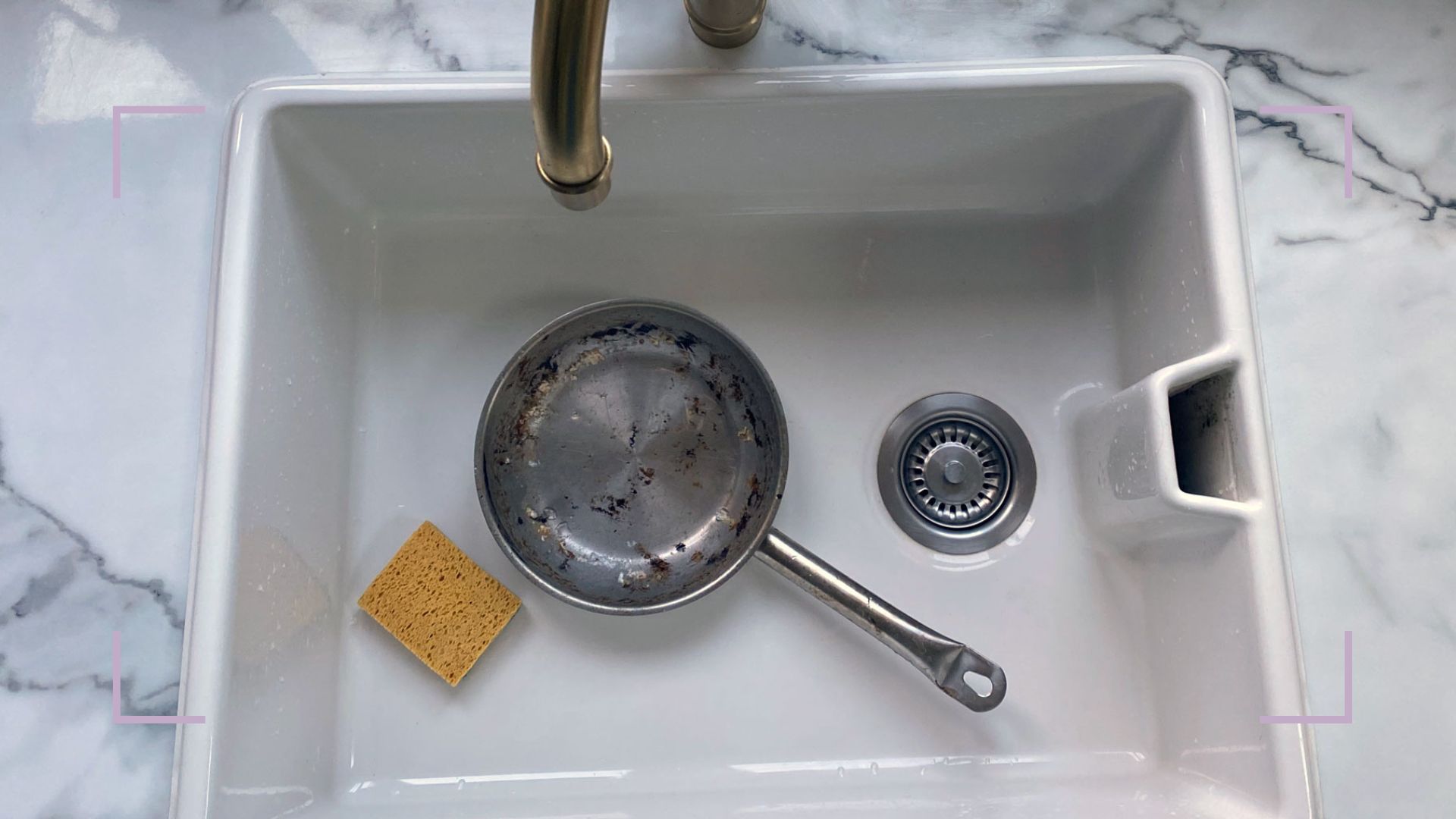
Tamara Kelly
Knowing how to clean a burnt pan is a necessary skill for any cook. It can be all too easy to leave saucepans on the hob for a few moments too long or crank up the heat too high. Before you know it, you've got a pan that looks like it'll never be clean again, no matter how hard you scrub.
Even if you use the very best cookware, it can sometimes be too tricky to clean burnt-on food with the usual sponge and soap combination.
But the good news is that there are some incredibly easy pan-cleaning tricks – using household ingredients you'll already have to hand, from cleaning with vinegar to using lemons these gentle solutions will spare you both elbow grease and damage to your pan.
How to clean a burnt pan – 6 easy methods that work
The following methods for cleaning a burnt pan can be applied to most cookware pieces, whether you prefer the best induction pans or the best stainless steel pans. But it's worth noting that different pans can benefit from different cleaning approaches. If you are tackling any specialist pans, like cast iron skillets, there may be gentler ways of cleaning when it comes to how to clean a cast-iron skillet for example.
If you're concerned about a particularly special pan, test each method on a small area first.
1. Loosen burnt-on glaze with boiling water and soap
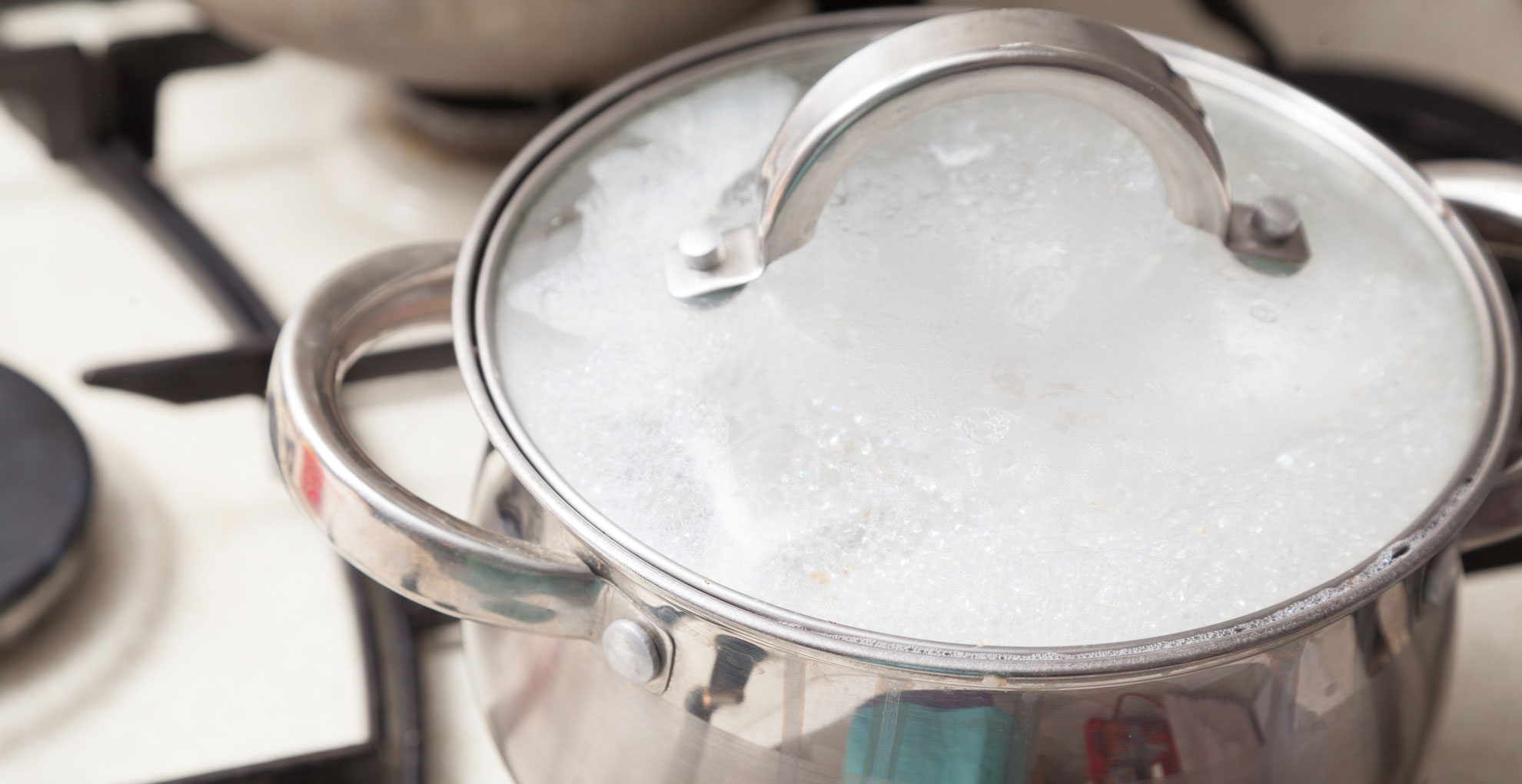
The gentlest approach to take for cleaning a burnt pan is to simply simmer boiling water in an attempt to lift the glazed, burnt-on residue. This method to one to try first to avoid having to raid an organized pantry for ingredients, it's also gentle on all surfaces and therefore ideal for cleaning with care.
"For scorched pans, add several drops of liquid soap into the pan filled with boiling water," advises cleaning expert, Heather Barrigan from MyJobQuote. "Boil for 10 minutes, remove it from the heat, and allow it to cool completely before scrubbing with the abrasive side of a dish sponge."
Sign up for the woman&home newsletter
Sign up to our free daily email for the latest royal and entertainment news, interesting opinion, expert advice on styling and beauty trends, and no-nonsense guides to the health and wellness questions you want answered.
We would recommend using a silicon spatula to gently help lift the burnt remains from the bottom of the pan if you are cleaning a stainless steel pan, to avoid any abrasive material scrubbing the surface.
2. Boil lemons to lift the burn
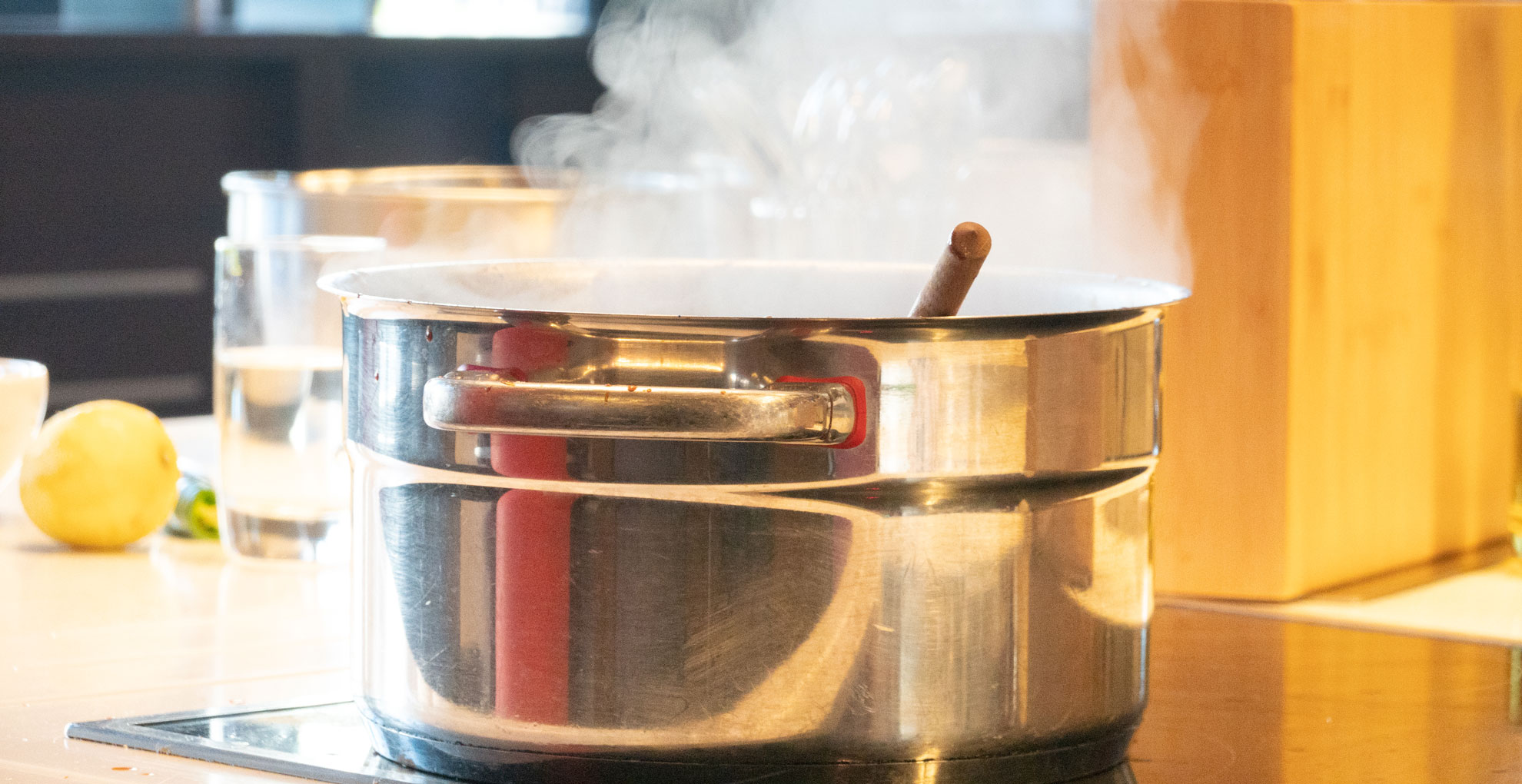
Another simple way to gently loosen a lightly burnt glaze on the bottom of your pan is to add two to three diced lemons to boiling water. "For burnt pans, add lemon before boiling to lift stains off steel and enamel," advises Heather.
This method follows the same steps as above, simply fill a pan with water and quarters of lemon and boil for 5-10 minutes to let the acidity of the citrus-infused water work its magic. After this time simply rinse clean, no scrubbing is required.
3. Use salt as a 'pan exfoliator'
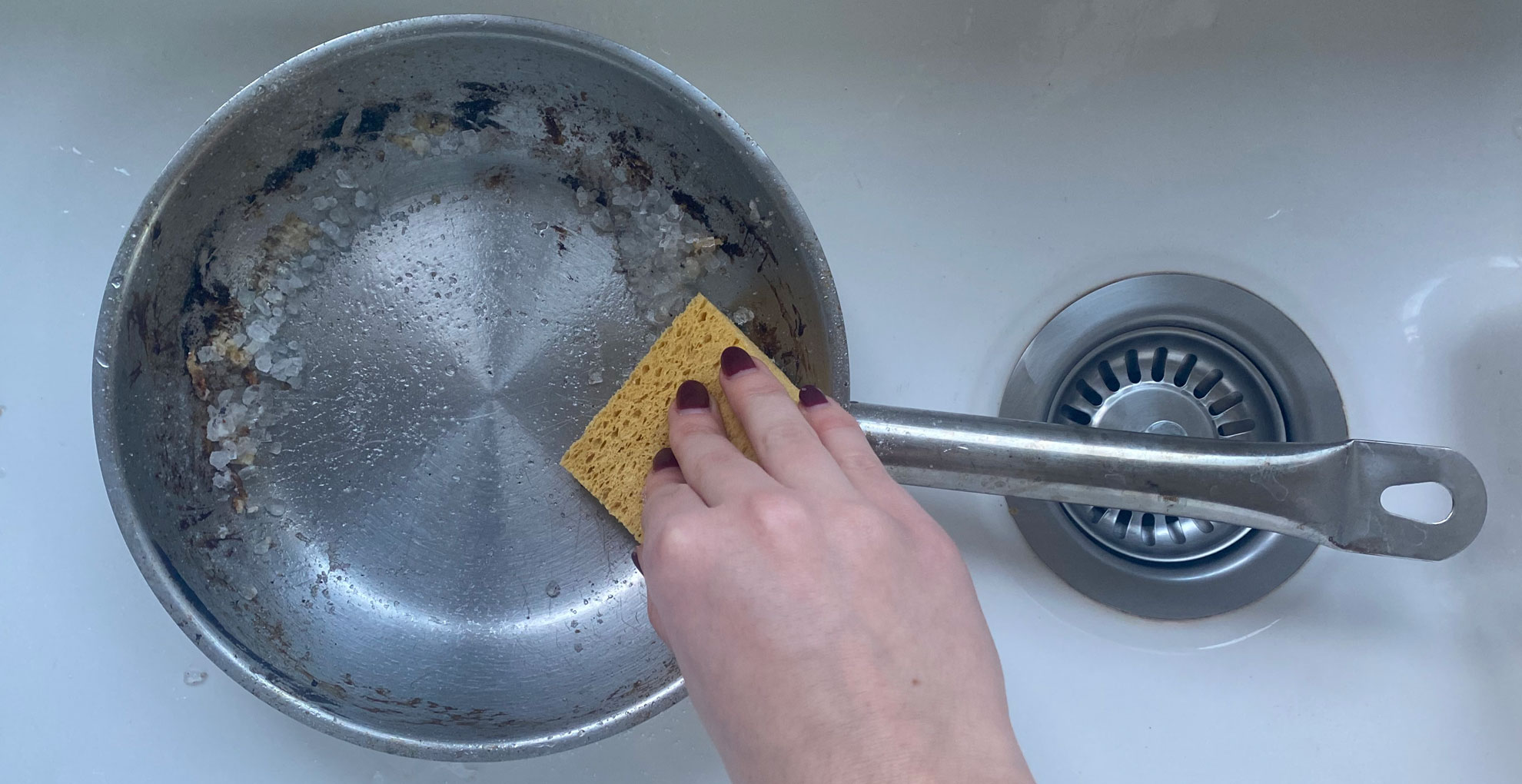
Editor Rachael Martin trying out the salt method for cleaning a burnt pan
Standard table salt can be used to tackle pans that are lightly burnt or scorched. This is often a good option for a recent burn, for the very efficient among us who get down to cleaning just after they've eaten their meal.
So how do you do it? It couldn’t be easier. Simply sprinkle a generous amount of salt into the pan in question and use a damp sponge to ‘work’ the salt into the burn. Keep repeating the process until the burn has vanished.
Heather recommends this method for cast iron pans especially, saying: "With cast iron or copper pans, do not use lemon as this could corrode the pan. Instead, generously sprinkle sea salt and scrub the burn marks off with a clean washcloth. Rinse and spray cooking oil on the surface of your pan to fill in the pores and create a smooth, non-stick surface." This process supports how to season a cast iron skillet to provide a protective surface to avoid any future burnt food traces.
4. Try a mix of baking soda and vinegar
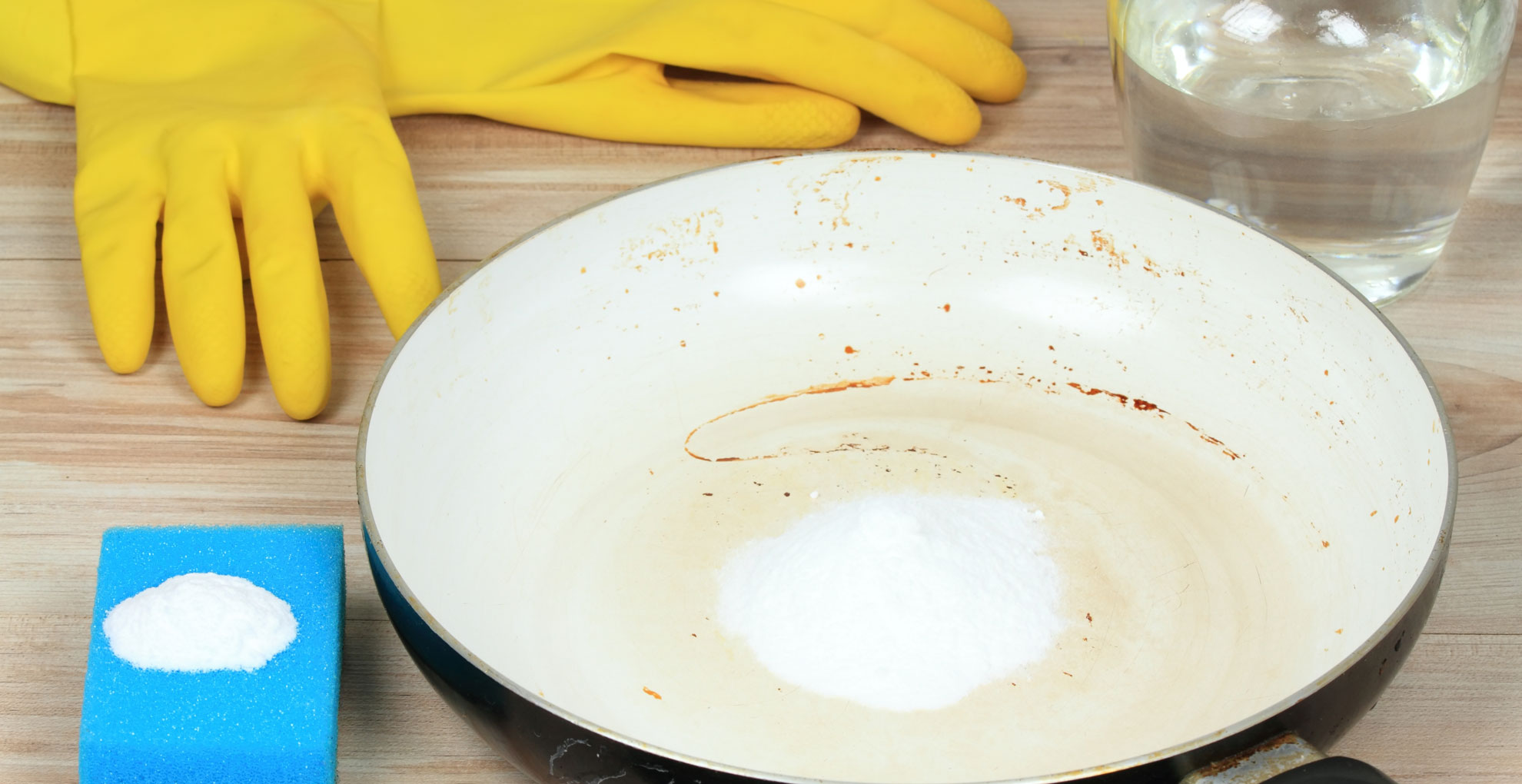
Baking soda and vinegar are the unsung heroes of many cleaning emergencies, including cleaning a fridge, cleaning an oven, and even cleaning a dishwasher. So unsurprisingly, it's a great option to help you tackle burnt pans.
“A homemade combination of baking soda and vinegar is more than enough to deal with most pan cleaning emergencies,” says Antoaneta Tsocheva, founder of cleaning company FastKlean. “Cleaning burnt pans with baking soda and vinegar is quick and straightforward, and will help you tackle leftover residue and odors, all without damaging it.”
Antoaneta's simple three-step method for using baking soda to salvage burnt pans is as follows:
- Step 1: Fill the burnt pan with enough water to cover the base. Pour in one cup of distilled white vinegar, pop the pan on your stove and turn on the heat. When it starts boiling, remove it from the heat.
- Step 2: Place your pan on a heat-resistant surface, add two tablespoons of baking soda and leave for a couple of minutes. When it begins to hiss, pour the mixture down the sink and give the pan a minute to cool off.
- Step 3: Start washing your pan. Gently use a non-wire scrubbing brush to deal with any leftover marks.
It’s worth noting that when it says ‘for a couple of minutes’ in step two, that’s precisely how long it should be left. “Don’t leave your pan unattended for any longer than this, as prolonged exposure to vinegar could damage it,” warns Antoaneta.
5. Use Coca-Cola for stubborn burns
You might not have considered Coca-Cola to be much of a cleaning ingredient, but when it comes to how to clean a burnt pan quickly, it can actually be incredibly useful. Much like it can be used to clean pennies or defrost window screens, Coca-Cola can also be used to shift burn marks.
If you’re dealing with stubborn burns and are in no rush to reuse the pan, simply pour a generous amount of Coca-Cola into your pan and leave it to sit for an hour. Letting it soak should allow the food to soften and release, meaning you can then remove any leftovers with a soft sponge or plastic scraper.
Finish off the cleaning with a quick wash with normal dish soap, and your pan should be as good as new. This is an easy, hands-off approach that may be most helpful if you need an easy solution, fast.
6. Use a dryer sheet for tough burn marks
A laundry dryer sheet might sound like an unlikely option for dealing with food-burnt pans, yet again, but it’s surprisingly effective for helping to budge tough marks that might have accumulated in your pans.
“Soak the pan in warm, soapy water and fully submerge a dryer sheet within it,” recommends Antoinette Daniel, founder of award-winning ethical cleaning agency, Just Helpers. “Leave it to soak for at least an hour, rinse, and then use a sponge or cloth to remove the now sludge-like burnt substance. It sounds bonkers but it works!”
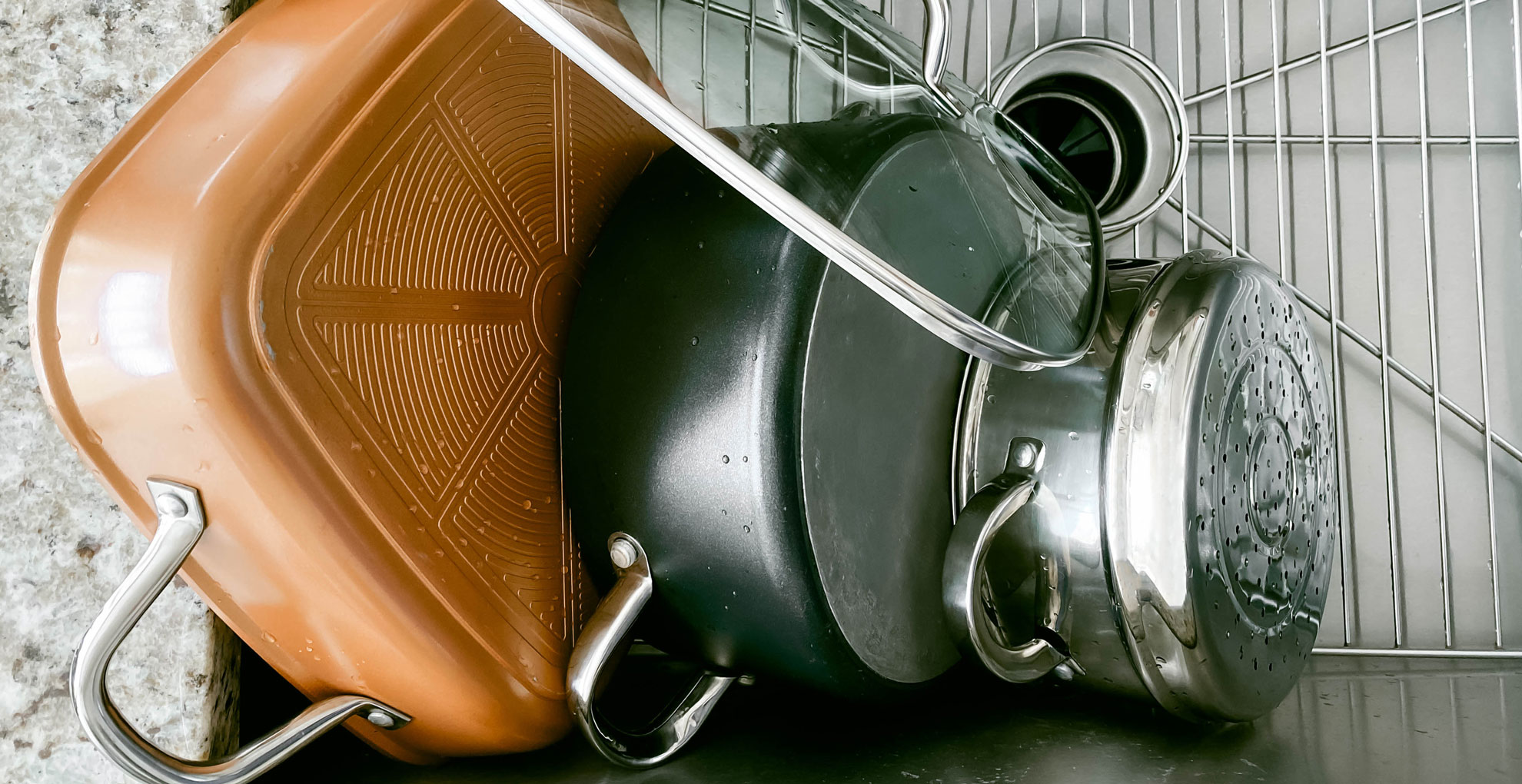
What you should never use to clean a burnt pan
The rules around what you should never use when it comes to how to clean a burnt pan can depend on the types of pans you have. But some general, good-practice rules to stick to are:
- Avoid metal/abrasive cleaning tools: The surface of delicate pans can be easily damaged when you’re trying to scrub off the remainder of yesterday’s casserole. “I would definitely recommend avoiding any metal sponges or pads,” says Antoinette. A top tip for when cleaning stainless steel. “They will essentially scratch the surface of the pan, making it more prone to future burns.” Instead, use a standard dish sponge or an old toothbrush, they’ll prevent unwanted scratches whilst being just as effective at shifting residue.
- Avoid harsh commercial detergents: Although some of the best oven cleaners are powerful, pungent commercial mixes, Antoinette advises steering clear of these when it comes to your pans. "They can absolutely ruin your cookware,” she warns. Instead, enlist one of the homemade remedies above, for a more natural fix that will keep your precious pans damage-free.
How quickly should I deal with a burnt pan?
Much like doing the washing-up, loading the dishwasher, or cleaning the kitchen after cooking, the desire to put off tackling a burnt pan and leave it to the next day is understandable. However, handling it sooner rather than later is definitely the best course of action if you want to preserve your pan.
“The quicker you deal with a burn, the quicker you can rescue your pan,” explains Antoinette. “The temptation will be to face the music on another day but dealing with it while it’s still fresh and warm could mean that by the time you’ve finished eating, the stain literally melts off.”
In some cases, burns can be rescued there and then. “If I spot a burn while I’m cooking, I add water to the pan and use a wooden spatula to loosen it,” says Antoinette. “If it’s more serious, I’ll transfer the food to another pan so I can continue cooking while I deal with it.”
Of course, dealing with it instantly isn’t always possible. But whether you deal with the burn straight away, or leave it for a few hours, there are a handful of tricks you can try out to help you learn how to clean a burnt pan with minimal fuss.
Katie Byrne is a contributor to woman&home and a writer whose interests span everything from homes and interiors, to pop-culture, travel, business and self-development. A former digital editor, her freelance journalism has featured across a wide range of print and online titles, including Raconteur, Digital Spy and more. When she's not writing, she loves reading (and has the groaning bookshelves to prove it...), dreaming up new décor ideas for her flat and devouring Netflix's latest true-crime series with her husband. You can find her on Twitter: @katie_b123.
- Tamara KellyLifestyle Editor